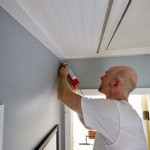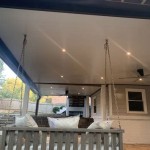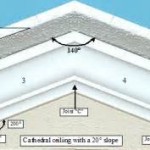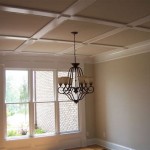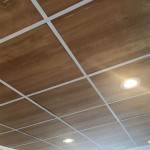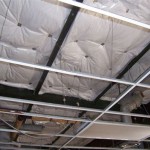Images Latest False Ceiling Design For Living Room: A Comprehensive Guide
The living room serves as a focal point within a residence. It functions as a space for relaxation, entertainment, and socialization. As such, its design necessitates careful consideration, particularly concerning the ceiling treatment. False ceilings, also known as dropped ceilings or suspended ceilings, have become increasingly popular for enhancing the aesthetic appeal and functionality of living rooms. A crucial aspect in selecting a false ceiling lies in identifying the latest designs that complement both the architectural style of the space and the homeowner's individual preferences. This article provides a comprehensive overview of recent trends in false ceiling designs for living rooms, accompanied by considerations for implementation and potential benefits.
False ceilings offer a multitude of advantages beyond mere aesthetics. They contribute to improved acoustics by absorbing sound, regulate temperature by providing insulation, and conceal unsightly wiring and ductwork. Moreover, they allow for the integration of recessed lighting, creating a customized and energy-efficient illumination scheme. Choosing the appropriate false ceiling design, therefore, is an investment in the overall comfort and value of the living space.
Key Considerations Before Installation
Prior to embarking on a false ceiling installation, several factors warrant meticulous evaluation. These include the room's dimensions, existing architectural features, budget constraints, and desired aesthetic. The room's height is a primary determinant; a low ceiling may not be suitable for elaborate designs that significantly reduce vertical space. Assessing the existing lighting scheme and considering the integration of new fixtures is also essential. Furthermore, selecting the appropriate materials, such as gypsum, plasterboard, PVC, or wood, is critical for achieving the desired look and ensuring longevity.
The structural integrity of the existing ceiling must be verified to ensure it can support the added weight of the false ceiling. Consulting with a qualified structural engineer or contractor is advisable, particularly for complex designs or when dealing with older structures. Additionally, local building codes and regulations should be adhered to throughout the design and installation process.
Budgetary considerations play a vital role in determining the scope and complexity of the false ceiling design. Material costs, labor charges, and the incorporation of lighting fixtures all contribute to the overall expenditure. Obtaining multiple quotes from reputable contractors is recommended to ensure competitive pricing and avoid unexpected costs.
Popular False Ceiling Designs for Living Rooms
The realm of false ceiling designs for living rooms is characterized by diversity and innovation. Various styles cater to different tastes and architectural contexts. Some prevalent designs include:
Gypsum Board Ceilings: Gypsum board, also known as drywall or plasterboard, is a widely used material for false ceilings due to its versatility, affordability, and ease of installation. It can be easily cut, shaped, and painted to create a variety of designs, ranging from simple flat surfaces to intricate patterns. Gypsum board ceilings are also fire-resistant and offer good sound insulation properties.
Suspended Grid Ceilings: These ceilings consist of interlocking metal grids suspended from the existing ceiling, with tiles or panels placed within the grid framework. Suspended grid ceilings are a practical choice for concealing wiring and ductwork, as they allow for easy access to these systems for maintenance. They are commonly used in commercial spaces but can also be adapted for residential applications with appropriate design choices.
Wooden Ceilings: Wood adds warmth and natural beauty to any living space. Wooden false ceilings can be constructed from solid wood planks, plywood panels, or engineered wood products. They offer a range of design possibilities, from rustic and traditional to modern and minimalist. Wood ceilings can be stained, painted, or left in their natural finish to complement the room's décor. However, it's crucial to treat wood properly to prevent moisture damage and insect infestation.
PVC Ceilings: PVC (polyvinyl chloride) ceilings are a cost-effective and water-resistant option for living rooms. They are lightweight, easy to install, and require minimal maintenance. PVC ceilings are available in a variety of colors, patterns, and textures, allowing for customization to suit different design preferences. They are particularly suitable for areas prone to moisture, such as basements or rooms with high humidity.
Coffered Ceilings: Coffered ceilings feature recessed panels or compartments, creating a three-dimensional effect. They add visual interest and architectural detail to a room, imbuing a sense of grandeur and sophistication. Coffered ceilings can be constructed from various materials, including wood, gypsum board, or plaster. They are typically more expensive than simpler ceiling designs but can significantly enhance the aesthetic appeal of a living room.
Tray Ceilings: Tray ceilings are characterized by a central recessed area or "tray" that is higher than the surrounding ceiling. They add height and dimension to a room, creating a more spacious and airy feel. Tray ceilings can be enhanced with decorative moldings, lighting fixtures, or paint to further accentuate their design. They are a versatile option that can be adapted to various architectural styles.
Island Ceilings: These are sections of false ceilings constructed to highlight a specific area, such as a seating area or a dining space. They are commonly used to create a focal point within a larger living room. Island ceilings can be designed and crafted from different materials and styles, providing a great deal of creative control to homeowners. They may incorporate unique lighting or textures to further draw attention.
Integrating Lighting into False Ceiling Designs
Lighting plays a pivotal role in the overall ambiance and functionality of a living room. Integrating lighting into false ceiling designs offers a seamless and visually appealing way to illuminate the space. Recessed lighting, such as pot lights or downlights, is a popular choice for false ceilings as they provide uniform and glare-free illumination. These fixtures can be strategically placed to highlight specific areas or architectural features.
LED strip lighting is another versatile option for false ceilings. These flexible strips can be concealed within the ceiling structure, creating indirect lighting effects that add warmth and depth to the room. LED strip lighting can also be used to accentuate the edges of the ceiling or to create decorative patterns.
Pendant lights and chandeliers can be suspended from false ceilings to provide both ambient and task lighting. These fixtures can serve as focal points and add a touch of elegance to the living room. The selection of pendant lights and chandeliers should be carefully coordinated with the style and design of the false ceiling.
Smart lighting systems, which allow for remote control of lighting through smartphones or voice commands, are also gaining popularity. These systems offer convenience and energy savings, as they can be programmed to adjust lighting levels based on time of day or occupancy.
Material Selection and Sustainability
The choice of materials for false ceilings has significant implications for both aesthetics and environmental impact. Selecting sustainable and eco-friendly materials is becoming increasingly important in contemporary design. Gypsum board made from recycled materials, wood sourced from sustainably managed forests, and PVC products with low volatile organic compound (VOC) emissions are all viable options.
Durability and longevity are other critical considerations. Materials that are resistant to moisture, fire, and pests will ensure that the false ceiling maintains its appearance and functionality for years to come. Proper installation and maintenance are also essential for maximizing the lifespan of the ceiling.
The embodied energy of the materials, which refers to the energy consumed in their production and transportation, should also be taken into account. Choosing locally sourced materials can help to reduce the environmental impact associated with transportation.
Latest Trends in False Ceiling Design
The field of false ceiling design is subject to continuous evolution, reflecting changing aesthetic preferences and technological advancements. Current trends include:
Minimalist Designs: Clean lines, simple shapes, and neutral colors characterize minimalist false ceiling designs. These designs emphasize functionality and understated elegance. They are well-suited for contemporary living spaces.
Geometric Patterns: Geometric shapes, such as squares, triangles, and hexagons, are increasingly being incorporated into false ceiling designs. These patterns add visual interest and a sense of dynamism to the room.
Textured Surfaces: Textured finishes, such as embossed patterns or rough aggregates, are used to create tactile and visually engaging false ceilings. These surfaces can add depth and character to the living room.
Biophilic Designs: Biophilic design principles, which seek to connect people with nature, are being applied to false ceilings. This includes incorporating natural materials, such as wood or bamboo, or using lighting to simulate natural sunlight.
Acoustic Panels: The demand for improving the acoustics of a room is increasing and is resulting in designs that place an importance for the incorporation of acoustic panels for sound absorption in home theatre rooms or living rooms. This often will result in a blend of aesthetic and functional designs.
Maintenance and Care
Proper maintenance is essential for preserving the appearance and extending the lifespan of a false ceiling. Regular cleaning, using a soft brush or vacuum cleaner, can remove dust and debris. Stains can be treated with mild detergents and water. Avoiding harsh chemicals or abrasive cleaners is crucial, as they can damage the ceiling surface.
Inspecting the ceiling for cracks, sagging, or water damage is recommended regularly. Any issues should be addressed promptly to prevent further deterioration. Repairs should be performed by qualified professionals to ensure the structural integrity of the ceiling.
In conclusion, selecting the appropriate false ceiling design for a living room involves careful consideration of various factors, including room dimensions, budget constraints, aesthetic preferences, and environmental impact. By understanding the different design options, materials, and lighting integration techniques, homeowners can create a living space that is both visually appealing and functionally enhanced.

Modern False Ceiling Designs For Drawing Rooms Elevate Your Space Beautiful Homes

Best False Ceiling Design Ideas For Living Rooms In 2025 Gyproc

Stunning Ceiling Design Ideas For Drawing Rooms

Best False Ceiling Design In Hyderabad At 45 Sq Ft Id 2855722963188

False Ceiling Designs You Can Actually Use 72 Rates
.jpg?strip=all)
20 False Ceiling Design Ideas To Transform Your Home Decor

50 Budget Friendly False Ceiling Designs For Every Home 2025

Best False Ceiling Design Ideas For Living Rooms In 2025 Gyproc

Top 100 Living Room False Ceiling Design Ideas 2024 Pop Designs For

Best False Ceiling Designs For Living Room Designcafe
Related Posts

